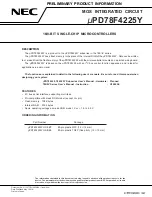
4-Port USB 2.0 Controller
Datasheet
SMSC USB20H04
Page 17
Revision 1.63 (03-30-07)
DATASHEET
7.5 Serial
Interface
External configuration data is loaded via the serial interface. The serial interface appears as either an
SMBus slave, or an I
2
C memory interface.
7.5.1 SMBus
Slave
The USB20H04 conforms to voltage, power, and timing specifications as set forth in the SMBus 1.0
Specification for Slave-Only devices. The SMBus interface shares the same pins as the EEPROM
interface. If the SMB_SEL_N pin is configured to activate the SMBus interface, external EEPROM support
is no longer available and the user-defined configuration values must be downloaded via the SMBus. A
separate
Application Note 9.29, "USB20H04 4-Port USB 2.0 Hub Controller - Configuration Programming"
provides details for configuring the USB20H04 via the SMBus.
7.5.2 I
2
C Memory Interface
A basic I
2
C-bus interface is provided for reading configuration data from an external EEPROM following a
reset. The USB20H04 acts as the master and generates the serial clock and the START and STOP
conditions.
7.6 Repeater
The hub repeater is responsible for managing connectivity between upstream and downstream facing ports
which are operating at the same speed. The repeater includes both a high-speed repeater function and a
full-/low-speed repeater function. When the upstream port is operating in a high-speed environment, traffic
passes through the high-speed repeater to downstream ports that are operating at high-speed. As detailed
in the USB specification, the repeater is responsible for managing connectivity on a ‘per packet’ basis. It
implements ‘packet signaling’ and ‘resume’ connectivity. If a low-speed device is detected the repeater will
not propagate upstream packets to the corresponding port, unless they are preceded by a PREAMBLE
PID.
7.7 SIE
Communication with the host is handled by the SIE. The full USB protocol layer is implemented in the SIE,
including Endpoint 0 and Endpoint 1. All standard USB requests from the host are handled by the
hardware without the need for firmware intervention.
7.8 Controller
The controller implements protocol handling at a higher level. By responding to SETUP packets it
coordinates enumeration, and it manages suspend/resume operation.
















































